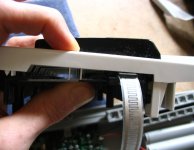the only force sensing resistor I can get hold of it is the channel aftertouch ribbons that you get in synthesiser keyboards, which are quite big like one meter. I've tried to get information on the commercial small force sensing resistors but digikey is selling them for about $30 each, so for the same price I could get a MIDI keyboard fsr (force sensing resistor) with a leftover keyboard. I've heard there are some foam ones about.
ideally I would like to make a flat thin resistor about 10k, doesn't have to be very exact...perhaps if I get some ordinary polyester and stick conductive Ink in it, when I compress it it should conduct 50% better? That would be perfect!
would love some help!
ideally I would like to make a flat thin resistor about 10k, doesn't have to be very exact...perhaps if I get some ordinary polyester and stick conductive Ink in it, when I compress it it should conduct 50% better? That would be perfect!
would love some help!
Attachments
That mylar track sticking out of the keyboard looks more like a capacitance type sensor. you squash foam with a conductive back which changes the capacitance.
I think the resistance would be much higher than you want but you could use antistatic foam with a conductor either side. Perhaps some blank mylar PCB sheet.
It all depends on the ergonomics of the device you are building, a set of electronic scales will have a strain gauge which is a ring of resistors, very small resistance change but you use the differential resistance with a lot of gain to give you a dc signal proportional to force.
If you don't want to design the electronics there are a lot of strain gauge driver boards available that give a 4-20mA current loop output for industrial applications.
I think the resistance would be much higher than you want but you could use antistatic foam with a conductor either side. Perhaps some blank mylar PCB sheet.
It all depends on the ergonomics of the device you are building, a set of electronic scales will have a strain gauge which is a ring of resistors, very small resistance change but you use the differential resistance with a lot of gain to give you a dc signal proportional to force.
If you don't want to design the electronics there are a lot of strain gauge driver boards available that give a 4-20mA current loop output for industrial applications.
No, that's probably an fsr. The silver-on-mylar interdigitating conductors are shunted by the conductive foam or a sheet of conductive rubber which changes resistance with compression. A particularly good way of doing it is to use a foam or rubber selected for the desired mechanical response and "feel," and adhering it to the back of a polyester sheet printed with a carbon ink loaded with a rough filler. You want a sheet resistance between 1k and 1k per square with filler in the 5-10 micron range. The sheet is faced against the interdigitating electrodes. The response of this sandwich sensor looks like a linear function of 1/(applied force) so has a much wider resistance swing than the rubber units.
The easiest way to make a force sensitive resistor is to sandwich a piece of black antistatic foam of the type used when packaging ICs between a couple metal contacts. As you apply pressure the resistance between the conductors will drop. Some foams are more elastic than others and will last longer with repeated compression/decompression cycles, while others will fall apart pretty quickly.
I_F
I_F
thank you for these interesting solutions. I will definitely have to engineer a home made sheet resistor or else find some stuff that can be used as a potentiometer from a moderate finger pressure.
I was going to fix them into the fingertips of a glove although it makes more sense to make a composite substrate of some kind.
I was going to fix them into the fingertips of a glove although it makes more sense to make a composite substrate of some kind.
- Status
- Not open for further replies.
